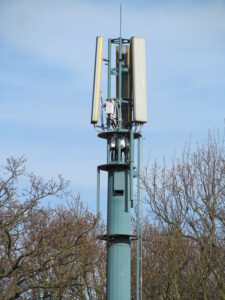[Image: “mobile phone mast” by osde8info is licensed under CC BY-SA 2.0 ]
New regulations come into force on 25th March 2022, called the Road Vehicles (Construction and Use) (Amendment) (No.2) Regulations 2022. These regulations amend the definition of hand-held devices; these are the definitions that will be used to govern the use of mobile phones and devices by drivers.
The offence
It is an offence for a person to drive a motor vehicle on a road if he is using a mobile phone or a hand-held device (as described in the regulations). It is also an offence to do so if you are the supervisor of a provisional licence holder.
Current law
At the moment, the law says that a mobile phone or hand-held device cannot be used while driving a vehicle. A hand-held device is defined as a device other than a two-way radio, which performs an interactive communication function by transmitting and receiving data.
A phone or device is treated as hand-held if it is or must be, held at some point during the course of making or receiving a call or performing any other interactive communication function.
An interactive communication function includes:
• Sending or receiving oral or written messages;
• Sending or receiving facsimile documents;
• Sending or receiving still or moving images;
• Providing access to the internet.
New law
The amendment substantially extends both the definition of a device and also the use of one.
Hand-held devices will be defined as a device, other than a two-way radio, which is capable of transmitting and receiving data, whether or not those capabilities are enabled.
A phone or device will be treated as hand-held in the same way as in the current law, but with an important amendment. The amended regulation will say the device will be treated as hand-held if it is, or must be, held while being used.
The word ‘using’ will include:
1. Illuminating the screen;
2. Checking the time;
3. Checking notifications;
4. Unlocking the device;
5. Making, receiving, or rejecting a telephone or internet-based call;
6. Sending, receiving, or uploading oral or written contact;
7. Sending, receiving or uploading a photo or video;
8. Utilising camera, video or sound recording functionality;
9. Drafting any text;
10. Accessing any stored data such as documents, books, audio files, photos, videos, films, playlists, notes or messages;
11. Accessing an application; or
12. Accessing the internet.
This list is far more extensive than the list under current law, which comes under interactive communication function. It should also be easier for the public to understand what they can and, more importantly can’t, do with a phone whilst the driver of a vehicle.
Defences
A device can be used in certain circumstances. Under current law, these circumstances are calling the emergency services, acting in response to a genuine emergency or if it is unsafe or impracticable for him to cease driving in order to make the call.
In addition, the regulation is not contravened if he is using the device to perform a remote-controlled parking function in particular circumstances.
The amendment takes into account advances in technology and provides that a device can also be used for a contactless payment made at a contactless payment terminal.
Penalty
The offence carries six penalty points with a maximum fine of £1000 (or £2500 if a goods vehicle or vehicle adapted to carry more than eight passengers). In the case of a person who has had a full driving licence for less than two years, this would mean the loss of a licence.
How can we help?
We ensure we keep up to date with any changes in legislation and case law so that we are always best placed to advise you properly. If you would like to discuss any aspect of your case, please contact any member of our vastly experienced Criminal Defence team, for assistance with any criminal law related matter.
–
Mr John Stokes (John.Stokes@danielwoodman.co.uk),
Mr Anthony Pearce (Anthony.Pearce@danielwoodman.co.uk) or
Mr Daniel Woodman (Daniel.Woodman@danielwoodman.co.uk).










